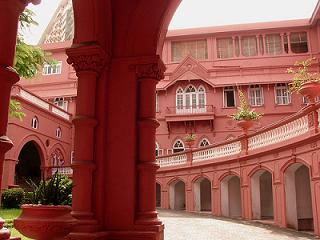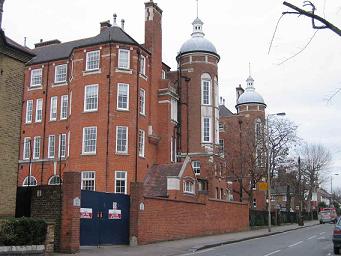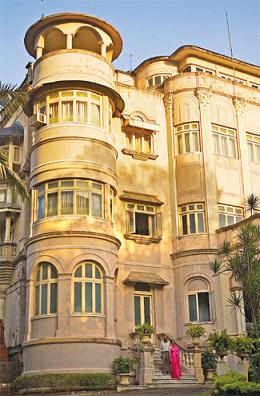Looking at the incredible concrete-and-glass jungle of high rise towers and business parks – as well as the sea links and highways – coming up in Mumbai, who would believe that this throbbing metropolis is home to some of the best conserved royal residences of India?
If you fly into Mumbai on a festival night, you see an unforgettable sight. The huge metropolis looks like a fairyland, spreading its cover of twinkling lights that reach the lapping seashores. From the suburban concrete jungles and the sprawling slums to the city’s hub in South Mumbai, it’s one endless picture of bustling roads full of millions of people, sleek speeding cars, buses and trains running as if there is no tomorrow. Even from the skies, the electric energy of the city can be perceived clearly.
Yet, behind this sprawling city which is called the financial capital of India, there hides the less-known story of rich Maharajas and Nawabs who built their magnificent palaces and resorts to be in touch with their British Raj rulers. Bombay, in the British Empire days, was a fast developing port and army entry point. Indeed, South Mumbai, till date is called the ‘Fort’ area signifying that it housed all business buildings and the cantonment of the British armed forces. Even today, the southern tip of Mumbai continues to be an army and naval base for western India.
In centuries gone by, Mumbai was a tiny cluster of seven fishing islands – with seven little temples set up by the resident communities. Over the 250 years of the British Raj era, South Mumbai became a landing port for the Empire’s forces and Governors began to build the city in the Revival Gothic architecture – mixed with traditional Indian features – which literally copied the elite look of London, transferred to India, the jewel in the crown of the British royalty. Among them was Sir Bartle Frere who created the world’s only group of majestic14 utility buildings in the Fort area among which was a college, a market, a bank, a university, a court, a museum, a clock tower, railway stations, hospitals, post office and so on – all set near the seashore and surrounded by huge green expanses and gardens. Without the present reclaimed Queen’s Necklace, the sea was close and British soldiers coming to Bombay could see a ‘duplicate’ London skyline from afar to assuage their homesickness.
As Bombay developed under the British, the city’s plush hill area overlooking the sea attracted the Maharajas and Nawabs who lived under the umbrella of British protection. Some of them built beautiful palaces and came to the city to seek honors and favors from the imperial rulers. These edifices continue to dot the verdant South Mumbai and have been conserved as consulates, educational institutions or residences for industrialist families.
Among all, the beautifully designed Sophia College on the Peddar Road hill is outstanding. Originally called Somerset House and owned by the East India Company with rich Parsi families, it was first purchased by the Holkar royal family of Indore in 1923 and was owned later by the Maharaja of Bhavnagar until it became a college in 1940. Today, the college, with its winding staircases, regal arches, decorative porticos and windows, is an outstanding example of Victorian architecture in Mumbai. Near the Gateway of India, stands the Dhanraj Mahal, the former palace of the Raja Dhanrajgir of Hyderabad. Today, it comprises naval flats and the residences of wealthy families.
Along the sea front on Warden Road, stands the American Consulate which occupies the erstwhile 10,000 sq. yd. palace of the Maharaja of Wankaner. This beautiful building was called Wankaner Palace until the US Government leased it and converted it into its consulate. Just a few metres ahead stands the Atomic Energy Commission’s residential building, which is housed in the sprawling palace of the Maharaja of Vansda. Along Napean Sea Road, one also sees the Walsingham House School, the palace of the Maharana of Kutch. Nearby is the Patiala Palace, now the residence of the Kilachand industrialist family. Along Worli Sea Face, stands the Samudra Mahal Palace, the former residence of the Maharaja Scindia of Gwalior!
Even in the hurly burly of the fast-spreading jungle of concrete, steel and glass, with across-the-sea-links and flyovers, these beautiful relics of the Raj era stand silhouetted beautifully against the city’s skyline. Their ambience and architecture opens a page of the history of this unique city of India which is now known as Mumbai, the financial hub of the nation. Many conservationists and architects have fought hard to maintain these palaces in their original splendour and to give them due credit, they have succeeded hugely. These valiant activists have given even a relatively young city like Mumbai a unique sense of history and nostalgia!
The author was Editor of Femina for 25 years. Vimla Patil is among India's senior most Journalists-Media persons. She excels in writing lifestyle pieces, women's concerns, travelogues, celebrity interviews, art-culture pieces about India. Visit her site www.vimlapatil.com

Palaces Sophia College

Palaces Walsingham School

Palaces Kilachand House